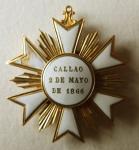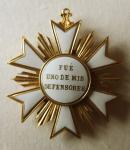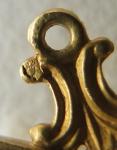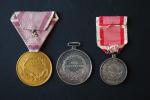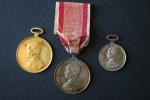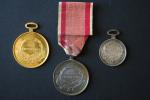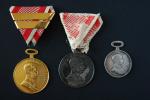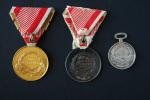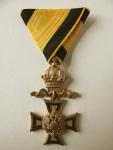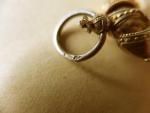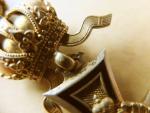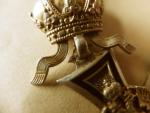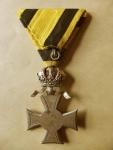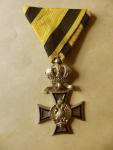-
Posts
1,161 -
Joined
-
Last visited
-
Days Won
17
Content Type
Profiles
Forums
Blogs
Gallery
Events
Store
Everything posted by Elmar Lang
-

Battle of Callao Cross in Gold
Elmar Lang replied to Elmar Lang's topic in Rest of the World: Militaria & History
I do agree with Paul's opinion. The seller said that he bought the Callao cross with other jewels, brooches and a few (already sold) austrian medals, from a family in Vorarlberg. At an antiques fair, I would expect to find "usual" orders/medals. This one was a true surprise. If medals could speak... Enzo -
Hello, a couple of weeks ago, I've visited an antiques fair in Innsbruck. Curiously to say, the only fine piece that attracted my attention was a South American piece, that I've purchased after a kind discussion with the seller. It's a cross in gold for the battle of Callao, May 2nd, 1866. Pity that the suspension ring is missing and that one arm has an enamel damage, but I'm feeling quite happy for this curious and rather uncommon find. A mystery is how this decoration arrived in Austria... An almost identical piece, was sold in Basel, at the Tammann sale on November 4th/5th, 2008, lot 747. Some pictures of the obverse, reverse and of the mark, struck on the suspension loop:
-
You're welcome, Michael. I don't have other medals of this type (I collect Imperial Austrian Orders & Decorations), but being Italian, I like to be well documented about our own award system. I should check in Mr. Brambilla's work (vol. II), where all the awards of the Italian Republic are listed and described. I think there were at least two more medals, for state visits to South America. Best wishes, E.L.
-

Austria-Hungary Fur Tapferkeit
Elmar Lang replied to Igor Ostapenko's topic in Austro-Hungarian Empire
As a matter of interest and if it could be useful to anyone, I would like to post some pictures of my Tapferkeitsmedaillen of Franz Josef: the 1849-1859; the 1859-1866 and the 1866-1914 types: -

DDR DDR National Anthem
Elmar Lang replied to Paul R's topic in Germany: Post 1945: Bundesrepublik & DDR
It's a pity that the video is not available anymore, but the "Auferstanden aus Ruinen" Anthem is not difficult to find anyways. E.L. -

Austria-Hungary 40 Year Long Service Decoration
Elmar Lang replied to Yankee's topic in Austro-Hungarian Empire
...and my own piece of the interesting variation with the "Rudolphine" crown (as illustrated in Mericka's book, page 190, ill. 122 - 17/d/l): -

Austria-Hungary 40 Year Long Service Decoration
Elmar Lang replied to Yankee's topic in Austro-Hungarian Empire
-

Austria-Hungary 40 Year Long Service Decoration
Elmar Lang replied to Yankee's topic in Austro-Hungarian Empire
-

Austria-Hungary 40 Year Long Service Decoration
Elmar Lang replied to Yankee's topic in Austro-Hungarian Empire
-

Austria-Hungary 40 Year Long Service Decoration
Elmar Lang replied to Yankee's topic in Austro-Hungarian Empire
-

Austria-Hungary 40 Year Long Service Decoration
Elmar Lang replied to Yankee's topic in Austro-Hungarian Empire
Hello, as promised, I would like to add the pictures of my 1st Class, officers' Militärdienstzeichen for 50 years service. The piece is in gilt silver and black enamel; the suspension loop is struck with the "A"; "Windhundkpof" and "FR" marks, while the suspension ring is struck with the "Windhundkopf" and "FR" marks. Obverse: -

Austria-Hungary 40 Year Long Service Decoration
Elmar Lang replied to Yankee's topic in Austro-Hungarian Empire
Hello, this is a most interesting discussion indeed. In the next weeks, I will organize myself to take some pictures of my Militärdienstzeichen, including the gilt silver 1st Class cross I've recently added to my collection. It's interesting to know that very few officers, besides the Emperor himself, were entitled for the highest class: is the list available? Best wishes, E.L. P.S.: I agree: Vaclav Mericka was one of the deepest scholars in phaleristic: I hope one day his unpublished studies would be printed and his immense collection catalogued and published. -
A very interesting excursus in the field of Italian and Italy's related medals of the Risorgimento. Just a little note: the Imperial Austrian "Metallenes Armeekreuz", a.k.a. "Kanonenkreuz" (in its italian regulations as distributed in the new "Regno Lombardo-Veneto", the decoration had an official, italian name: "Croce Metallica d'Armata"), was made of bronze from captured french cannons, but on its rim there wasn't any "AUS EROBERTEM GESCHUETZ" inscription. Only, the suspension loop was struck with the Imperial Mint mark: a two-headed eagle within a lozenge. Best wishes, E.L.
-

Austria-Hungary 40 Year Long Service Decoration
Elmar Lang replied to Yankee's topic in Austro-Hungarian Empire
Hello, I need to point out that the "Freigelassen" mark for precious metal is not the "F.R" within a rectangle or, later, the "FR" within a lozenge: both are marks of Rothe, Wien. I don't know what's the source from which Mr. McNamara knew that the "FR" mark would be a tax release one. The official marking system of Imperial Austria has been completely described in "Oesterreichs Orden" , Graz, ADEVA, 1996, pages 388-400, with illustration of all the assay and state marks officially used under Imperial control: more, almost all jewellers' marks are quoted and/or described at page 399: "C.F. ROTHE & NEFFE, Wien, Kohlmarkt: wohl berühmteste österreichische Ordensjuweliere, gergründet 1844, tätig als Ordensjuweliere bis vor kurzem, Firmenzeichen "FR" und "CFR"; Erzeugung aller österreichischen Orden vom Goldenen Vlies, Militär Maria Theresien-Orden, bis zu den einfachsten Auszeichnungen in allen Klassen und Materialien...". Best wishes, E.L. -

Italy Al Valore Militare
Elmar Lang replied to dedehansen's topic in Southern European & Balkan States
In Italy, what in Germany is called Spangenstück never bears any mint mark. They were made by private firms like Johnson, Lorioli, Pagani, etc. Interesting to see an unnamed, official medal. It's a pity that often, they fall into the hands of some "creative" people, trying to upgrade them with an attempt of an old, engraved naming, thus damaging an otherwise good piece. Best wishes, E.L. -

Italy Al Valore Militare
Elmar Lang replied to dedehansen's topic in Southern European & Balkan States
Hi, I know that named Al Valore medals to foreigners of the Axis powers, existed for sure. Usually, named pieces were those awarded after an operational phase, where the higher commands had time to collect proposals for awards. those accepted, had enough time to allow The Ministry of War in Italy, to order named medals to the Royal Mint. As said, the medals awarded "On the Field", were given out for instance from an Army Corps Command, that disposed of a certain number of unnamed medals, to be awarded very shortly after the date of an act of gallantry. Curiously, at a recent auction, Iìve had the opportunity to purchase three award documents of resp. a Silver, a Bronze and a Cross for Military Valour, to German Luftwaffe NCOs of the flying personnel, dating from 1941. The medals were missing though, but such documents to non-italians, are very rare. Best wishes, E.L. -

Italy Al Valore Militare
Elmar Lang replied to dedehansen's topic in Southern European & Balkan States
Hello, your piece is a fine specimen of the Italian Silver Medal for Military Valour, of the type awarded after WW1 and in the early WW2. Being unnamed, most possibly, it was awarded to a foreigner as a "on the field" ("Sul Campo") award. From the pictures I see the mint marks of the crowned "Z" and "F.G", that have to be on any officially awarded piece; the case is also the correct one. No wonder then, that the medal could have been awarded to a German soldier on one of the fronts where Italian and German troops fought together. In the Italian award system, the Silver Medal for Valour is the second highest award for gallantry and courage in combat. Best wishes, E.L. -

Austria-Hungary Austro Hungarian mark - star * - asterisk ?
Elmar Lang replied to Magician's topic in Austro-Hungarian Empire
Hello, no rumours at all. The "Star Mark" ("Stern-Punze" or "Sternchen-Punze") was adopted to mark all decorations made of gilt or silver-plated metal instead of gold or silver; not necessarily at the end of the war. All the best, E.L. -

Italy - Italian Artillery Insignia
Elmar Lang replied to Kev in Deva's topic in Southern European & Balkan States
I don't remember exactly, but the artillery badge with "vertical" flame above the grenade, should mean Heavy Artillery. Field Artillery has the horizontal flame; Horse Artillery (like the Italian batteries equipped with german 88mm. guns from the "1° Articelere" in North Africa), wore the badge with crossed cannons and sabres. The badge that started this thread is from the 1st Engineer's Regiment (Primo Reggimento Genio). I'm not sure whether he saw action in the North African campaign 1940-43. Best wishes, E.L. -
CAPUTO Vito, from Lecce, infantry soldier Silver Medal for Military Valour (Posthumous): "After his captain was killed in action, regardless of the enemy rifle and machine-gun fire, he hurried to recover him and, while he was taking the body upon his shoulders, fell killed. San Mauro, August 7th, 1916". Best wishes, E.L. P.S.: the medal bar looks like "upgraded": a soldier couldn't be awarded with the order of the Crown of Italy.
-
Hello, for all the colleagues interested in this field of phaleristic, I can announce that the new edition of A. Brambilla's book "Le Medaglie Italiane degli ultimi 200 Anni" (The Italian Medals from the past 200 years) was finally published. The first edition, appeared in the '80s, is now completely revised and illustrated in colour with detailed pictures of the original pieces, on nearly 600 pages. I can say that this is the best book now available on the subject, prepared in more than a decade of new research in archives and collections, either public or private ones. The book is written in Italian, but the author says that an English edition will be prepared too. Best wishes, E.L.
-

Imperial Russia Milit?r Maria Theresien Orden Bruststern on eBay?
Elmar Lang replied to KeithB's topic in Russia: Imperial
The breast star pictured above, actually doesn't look like a piece made by Rothe in Vienna, but in my opinion it can be a copy of a Rothe copy made by Horvath in Budapest, in the late '90s of 20th Century. Such copies of copies are made of cast metal (sometimes silver alloy), and the pin (cast from a Rothe copy too), bears the marks of Rothe. I agree with Paul, that a Rothe copy made in the '60s can be a very good substitute of a highly expensive MMThO Grand Cross. Collecting Rothe copies, can be interesting and amusing: the Viennese firm had dies to make orders from all over the world (and they made them even back in the 19th Century). I didn't know that Mr. Bl. attempted to marry one of the sisters Rothe. I knew the two ladies, back in the 70s: I remember two kind ladies patient enough to give answers to my questions (the typical, annoying questions of a young collector...). E.


